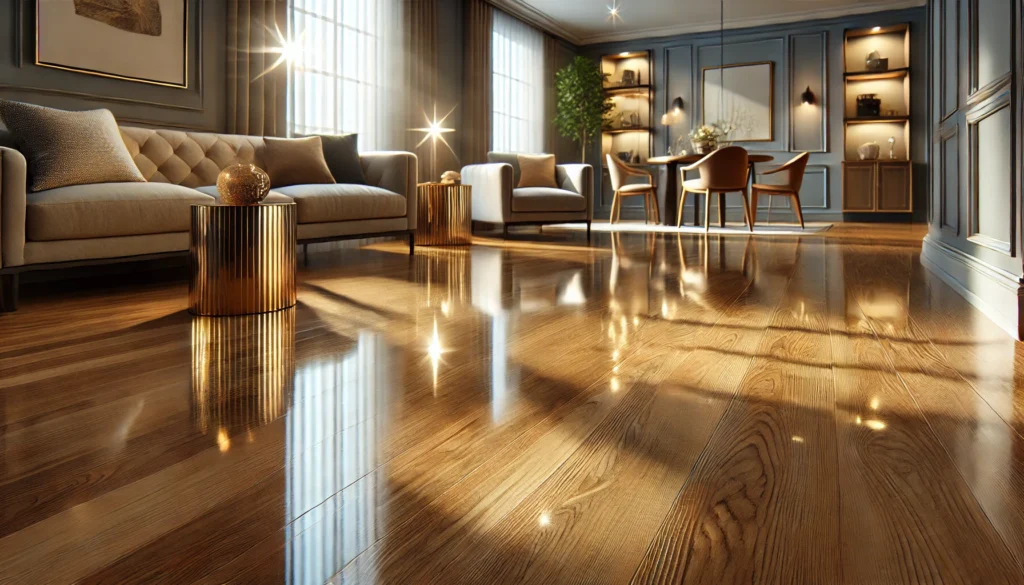Imagine this: You’ve just installed beautiful, sleek vinyl plank flooring. It’s a game-changer, completely transforming the look of your home with that luxurious finish. But soon, you start noticing smudges, dust, or perhaps even a sticky spot from a spill. You grab a mop and give it a quick clean, but the floor still doesn’t look as fresh as it did on day one. That’s when you realize—cleaning vinyl plank flooring isn’t as simple as it seems. It requires some specific TLC to keep it shining and in prime condition.
Why This Matters: Vinyl plank flooring is one of the most popular flooring choices today because it combines durability, water resistance, and affordability with a high-end look. However, while it’s designed to be tough, using the wrong cleaning techniques or products can easily lead to scuffs, dullness, or even long-term damage. This guide is here to help you understand exactly how to clean vinyl plank flooring so you can keep it looking its best with minimal fuss.
What You’ll Learn: This guide provides you with a step-by-step, easy-to-follow routine to make your vinyl plank floors shine. You’ll learn the importance of each cleaning step, get insider tips to avoid common mistakes, and gain insights into troubleshooting any problems that may arise along the way.
Benefits of Following This Guide:
- Saves time and effort with effective cleaning strategies
- Prolongs the lifespan of your flooring
- Keeps floors looking pristine without costly maintenance
- Avoids unnecessary damage from incompatible products or techniques
By the end of this guide, you’ll feel confident tackling any cleaning job on your vinyl plank flooring—let’s get started!

Step-by-Step Instructions for Cleaning Vinyl Plank Flooring
Step 1: Gather Your Cleaning Supplies
To begin, it’s essential to gather the right cleaning tools and products. Vinyl plank flooring is sensitive to certain cleaners, so using the wrong products may cause long-term damage.
What You’ll Need:
- Microfiber mop (flat or spray mop works best)
- Vacuum cleaner with a soft-brush attachment (or a broom)
- Mild, pH-neutral cleaner specifically for vinyl floors (like a homemade vinegar solution or a commercial vinyl-safe cleaner)
- Soft cloth or microfiber towel for spot cleaning
- Spray bottle for applying homemade solutions
Why It Matters: Using the right tools prevents scratches, scuff marks, and streaks. A microfiber mop is particularly effective at picking up dirt without leaving residue, while a soft-brush vacuum protects the vinyl from being scratched.
Pro Tip: Avoid steam mops, as the high heat can warp vinyl planks over time.
Step 2: Sweep or Vacuum the Floor
Before mopping, it’s crucial to remove loose dirt, dust, and debris from the floor.
- Vacuum: Use a vacuum with a soft-brush attachment to gently go over the floor, picking up dust and crumbs. Pay attention to corners and high-traffic areas.
- Sweep: Alternatively, use a soft-bristled broom if you don’t have a suitable vacuum. Avoid harsh bristles, as they can create micro-scratches.
Why It Matters: Grit and dirt particles can act like sandpaper on vinyl floors. Sweeping or vacuuming beforehand prevents these particles from scratching the surface when you mop.
Pro Tip: Vacuuming is generally more efficient than sweeping, especially if you have pets, as it also collects fur and allergens.
Step 3: Prepare Your Cleaning Solution
Once the floor is free of loose dirt, it’s time to prepare a gentle cleaning solution.
Option 1: Store-Bought Vinyl Cleaner
Many commercial vinyl cleaners are formulated specifically to be safe for vinyl planks. Check the label and follow the recommended dilution instructions if needed.
Option 2: DIY Cleaning Solution
A simple homemade solution works wonders too:
- Mix: 1 cup of white vinegar with 1 gallon of warm water
- Optional: Add a few drops of essential oil for a pleasant scent
Why It Matters: pH-neutral solutions clean effectively without breaking down the vinyl’s protective coating.
Pro Tip: Avoid any cleaner with harsh chemicals, such as ammonia, bleach, or abrasive ingredients, as they can dull or damage vinyl over time.
Step 4: Mop the Floor with a Damp Microfiber Mop
- Dampen the Mop: Dip your microfiber mop into the cleaning solution and wring it out thoroughly. The mop should be damp, not soaking wet.
- Mop in Sections: Start at one corner of the room and work your way across, mopping in small sections. Move the mop in gentle, straight lines to avoid streaks.
- Rinse and Repeat: If the mop head gets dirty, rinse it out and continue. This step is crucial for avoiding streaks.
Why It Matters: Over-wetting vinyl plank flooring can cause water to seep between planks, leading to warping or mildew growth.
Pro Tip: Avoid circular motions while mopping, as they can create streaks. A figure-eight motion can help to prevent this.
Step 5: Tackle Stubborn Spots and Spills
For dried-on spills or sticky spots, a little extra effort may be required.
- Spot Clean: Spray a small amount of your vinegar solution directly onto the spot and let it sit for a minute.
- Scrub Gently: Use a soft microfiber cloth or a soft-bristled brush to scrub the spot gently.
- Wipe Dry: After cleaning, use a dry microfiber towel to wipe the area and remove any remaining moisture.
Why It Matters: Allowing spills to sit can lead to staining or dulling of the finish. Spot cleaning promptly helps maintain the floor’s appearance.
Pro Tip: For oily or greasy spots, mix a small amount of mild dish soap with warm water to break down the residue.
Step 6: Dry and Buff the Floor
After mopping, it’s a good idea to dry and buff the floor to prevent water spots and add an extra shine.
- Towel Dry: Use a dry microfiber towel or mop to go over the entire floor. This step is especially important in humid areas.
- Buff for Shine: To add an extra sheen, gently buff the floor with a dry microfiber cloth.
Why It Matters: Drying ensures no moisture is left behind that could damage the floor. Buffing gives the vinyl a polished, clean look.
Pro Tip: For an extra shine boost, consider using a vinyl plank floor polish occasionally (once every few months). Follow the product’s instructions carefully to avoid buildup.
Read more: How to Clean LVP Flooring: The Ultimate Guide
Troubleshooting & Additional Tips
Common Issues & Fixes
- Streaky Finish After Mopping:
- Cause: Often due to too much cleaner or a dirty mop.
- Solution: Rinse the mop head more frequently and use a minimal amount of cleaner.
- Sticky Residue After Cleaning:
- Cause: Some cleaning products leave a residue when not fully rinsed.
- Solution: Mop again with plain water to remove the residue.
- Dull Appearance Over Time:
- Cause: Buildup of dirt or too frequent cleaning with strong solutions.
- Solution: Use a mild cleaner and avoid frequent deep cleaning. Buffing regularly helps maintain the shine.
Best Practices & Tips
- Avoid Using Wax: Vinyl plank flooring does not need waxing and can actually become more slippery with it.
- Use Furniture Pads: To prevent dents and scratches, place pads under furniture legs.
- Control Sun Exposure: Prolonged exposure to direct sunlight can fade vinyl. Use blinds or curtains to protect high-sun areas.
Read more: How to Clean Vinyl Floors: A Complete Guide for Pristine, Long-Lasting Flooring
Expert Insights
- Flooring Specialist Tip: “Vinyl plank flooring is designed for low-maintenance care. Avoid high-alkaline cleaners; these can erode the floor’s protective layer and leave it vulnerable to stains.” — Chris, Flooring Expert
Read more: Best Vinyl Floor Cleaner: Top Picks for a Sparkling Clean
FAQs about How to Clean Vinyl Plank Flooring
1. Can I use a steam mop on vinyl plank flooring?
No, steam mops can cause vinyl planks to warp due to excessive moisture and heat. Stick to a damp microfiber mop.
2. How often should I clean my vinyl plank flooring?
For high-traffic areas, vacuum or sweep daily and mop weekly. In less busy spaces, a bi-weekly or monthly cleaning routine should be sufficient.
3. Can I use vinegar on my vinyl plank floors regularly?
Yes, vinegar diluted with water is safe for vinyl and provides an eco-friendly cleaning option. Avoid high concentrations of vinegar to prevent any dulling over time.
4. What’s the best way to clean up pet accidents on vinyl?
Wipe immediately with a soft cloth and clean with a mild, pH-neutral solution to avoid staining or odor retention.
Conclusion
By following this guide on how to clean vinyl plank flooring, you’ll have floors that look as good as new, year after year. Remember to keep your cleaning routine simple—vacuum or sweep frequently, mop with gentle cleaners, and tackle spills right away. With these methods, you’ll protect your investment, enhance the look of your space, and make your cleaning efforts more efficient.
Take Action Today: Try these tips on your vinyl floors and notice the difference a well-planned cleaning routine can make. Share this guide with friends or explore additional cleaning guides for other floor types on our site!
